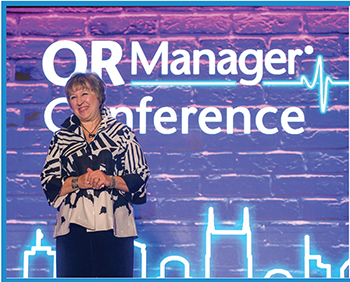New water quality standard released by AAMI

Water is a major component of medical device processing. It is used in cleaning solutions, rinse water, and to generate steam for sterilization. Because of its crucial role in medical device processing, the Association for the Advancement of Medical Instrumentation (AAMI) determined it was necessary to upgrade the Technical Information…
Mastering social media responsibility: A guide for OR leaders

In today’s digital age, social media channels such as Facebook, Instagram, YouTube, and TikTok are transforming the ways we connect and communicate. Through these platforms, users can share information, ideas, and personal messages, as well as build networks and communities. It is also becoming an integral part of everyday life.…
Editorial

Staffing crises continue to plague the healthcare industry, but that cannot continue to be the focus of perioperative leaders. That was the poignant message that underscored the attendee experience at the 36th OR Manager Conference in Nashville, Tennessee. After attending the engaging keynotes, numerous breakout sessions, and several networking events,…
Maximizing surgical excellence: Strategies for attracting top surgeons

A 2021 report by the Association of American Medical Colleges projects shortages of 15,800 to 30,200 in all surgical specialties by 2034. Driven by various factors, including the growing healthcare needs of an aging population, an aging surgical workforce—with many surgeons and nurses nearing retirement—and limited capacity in medical and…
Balancing the demand for OR time with resource utilization

ORs are a key revenue driver for hospitals, with surgical services accounting for nearly half of hospital margins. Efficient use of OR time is therefore critical to sustaining and growing hospital revenue and profitability. Perioperative leaders face an ongoing challenge in optimizing OR utilization, however, because of the common mindset…
Refreshed outlook for addressing healthcare’s staffing crisis
The COVID-19 pandemic has amplified existing personnel shortages in hospitals and ambulatory surgery centers (ASC), which are anticipated to persist. Before the pandemic, nursing supply and demand were already affected negatively by several factors, including approximately 70,000 Baby Boomer RNs retiring per year. As the remaining Baby Boomer RNs retire over…
Blast from the past: 10 tips on successful perioperative leadership for new managers

Perioperative nursing, like any field, requires authenticity, honesty, and integrity for successful management. As perioperative represents one of the most challenging and demanding healthcare environments, patient-centered leadership is a must. This article previously published by OR Manager, titled "Words of wisdom: OR leaders offer tips for new managers," expands on…
Blast from the past: 10 steps to building a business case for new technology

A previous issue of OR Manager included the article, "Building a business case for new technology," which featured tips from leaders at the University of Pittsburgh Medical Center on the importance of building a thorough business case for implementing new technology in the OR. With the next OR Business Management…

 Free Daily News
Free Daily News Career Center
Career Center